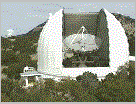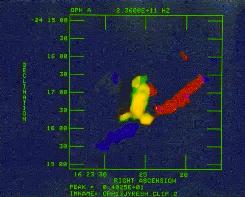Molecular Astrophysics
 National Radio Astronomy Observatory
National Radio Astronomy Observatory |

|
 National Radio Astronomy Observatory
National Radio Astronomy Observatory |

|

Molecular Astrophysics concerns the study of emission from molecules in
space. Lew Snyder recently presented a
list of the
110 currently known interstellar molecules. These molecules have large
numbers of observable transitions. To find specific frequencies, try
Herb Pickett's Molecular Spectroscopy Home
Page or Frank Lovas' list
of recommended rest frequencies. Tom Kuiper has put together
an explanation of
molecular radio spectroscopy for emission lines. Lines may
also be observed in absorption--for example the
highly redshifted lines seen against the
gravitationally lensed quasar PKS1830-211.
High energy radiation, such as ultraviolet light, can break the
molecular bonds which hold atoms in molecules. In general then, molecules
are found in cool astrophysical environments. The most massive objects
in our Galaxy are giant clouds of molecules and dust, creatively named
Giant Molecular Clouds. In these clouds, and smaller versions of them,
stars and planets are formed. One of the primary fields of study of
molecular astrophysics then, is star and planet formation. Molecules may
be found in many environments, however, from stellar atmospheres to those
of planetary satellites. Most of these locations are cool, and molecular
emission is most easily studied via photons emitted when the molecules make
transitions between low rotational energy states. One molecule, comprised
of the abundant carbon and oxygen atoms, and very stable against dissociation
into atoms, is carbon monoxide, CO. The wavelength of the photon emitted
when the CO molecules falls from its lowest excited state to its zero energy,
or ground, state is 2.6mm, or 115 gigahertz (billion hertz). This frequency
is a thousand times higher than typical FM radio frequencies. At these
high frequencies, molecules in the Earth's atmosphere can block transmissions
from space, and telescopes must be located in dry (water is an important
atmospheric blocker), high sites. Radio telescopes must have very accurate
surfaces to produce high fidelity images. NRAO pioneered development of
accurate antennas and high frequency receivers, and the development of
molecular astrophysics, with the 11m radio telescope. In 1982, the surface
of the 11m was replaced with a much more accurate 12m surface, pictured above.

 Protostars, just forming from their parent clouds.
Protostars, just forming from their parent clouds.


 Continuum emission: modified blackbody from cold dust
Continuum emission: modified blackbody from cold dust

 Spectral line emission: rotational transitions from molecular gas
(CO, CS, HCO+, H2O etc.) and fine-structure transitions from atomic species
(CI)
Spectral line emission: rotational transitions from molecular gas
(CO, CS, HCO+, H2O etc.) and fine-structure transitions from atomic species
(CI)

For comments, please send E-Mail to awootten@nrao.edu; last modified 22 Sept., 1995.